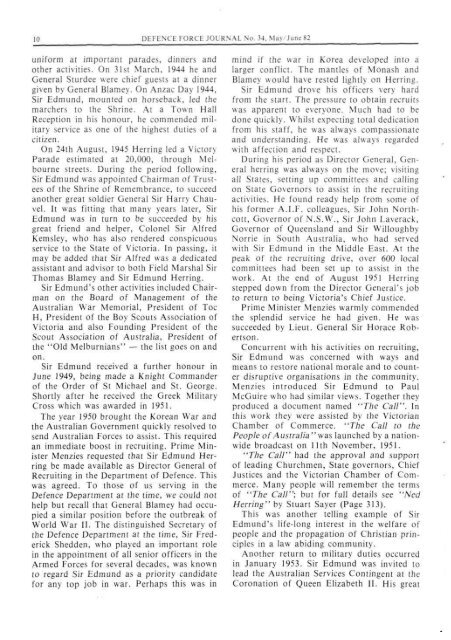ISSUE 34 : May/Jun - 1982 - Australian Defence Force Journal
ISSUE 34 : May/Jun - 1982 - Australian Defence Force Journal
ISSUE 34 : May/Jun - 1982 - Australian Defence Force Journal
Create successful ePaper yourself
Turn your PDF publications into a flip-book with our unique Google optimized e-Paper software.
10 DEFENCE FORCE JOURNAL No. <strong>34</strong>. <strong>May</strong> <strong>Jun</strong>e 82<br />
uniform at important parades, dinners and<br />
other activities. On 31st March, 1944 he and<br />
General Sturdee were chief guests at a dinner<br />
given by General Blarney. On Anzac Day 1944,<br />
Sir Edmund, mounted on horseback, led the<br />
marchers to the Shrine. At a Town Hall<br />
Reception in his honour, he commended military<br />
service as one of the highest duties of a<br />
citizen.<br />
On 24th August, 1945 Herring led a Victory-<br />
Parade estimated at 20,000, through Melbourne<br />
streets. During the period following,<br />
Sir Edmund was appointed Chairman of Trustees<br />
of the Shrine of Remembrance, to succeed<br />
another great soldier General Sir Harry Chauvel.<br />
It was fitting that many years later, Sir<br />
Edmund was in turn to be succeeded by his<br />
great friend and helper, Colonel Sir Alfred<br />
Kemsley, who has also rendered conspicuous<br />
service to the State of Victoria. In passing, it<br />
may be added that Sir Alfred was a dedicated<br />
assistant and advisor to both Field Marshal Sir<br />
Thomas Blarney and Sir Edmund Herring.<br />
Sir Edmund's other activities included Chairman<br />
on the Board of Management of the<br />
<strong>Australian</strong> War Memorial, President of Toe<br />
H, President of the Boy Scouts Association of<br />
Victoria and also Founding President of the<br />
Scout Association of Australia, President of<br />
the "Old Melburnians" — the list goes on and<br />
on.<br />
Sir Edmund received a further honour in<br />
<strong>Jun</strong>e 1949, being made a Knight Commander<br />
of the Order of St Michael and St. George.<br />
Shortly after he received the Greek Military<br />
Cross which was awarded in 1951.<br />
The year 1950 brought the Korean War and<br />
the <strong>Australian</strong> Government quickly resolved to<br />
send <strong>Australian</strong> <strong>Force</strong>s to assist. This required<br />
an immediate boost in recruiting. Prime Minister<br />
Menzies requested that Sir Edmund Herring<br />
be made available as Director General of<br />
Recruiting in the Department of <strong>Defence</strong>. This<br />
was agreed. To those of us serving in the<br />
<strong>Defence</strong> Department at the time, we could not<br />
help but recall that General Blarney had occupied<br />
a similar position before the outbreak of<br />
World War II. The distinguished Secretary of<br />
the <strong>Defence</strong> Department at the time, Sir Frederick<br />
Shedden, who played an important role<br />
in the appointment of all senior officers in the<br />
Armed <strong>Force</strong>s for several decades, was known<br />
to regard Sir Edmund as a priority candidate<br />
for any top job in war. Perhaps this was in<br />
mind if the war in Korea developed into a<br />
larger conflict. The mantles of Monash and<br />
Blarney would have rested lightly on Herring.<br />
Sir Edmund drove his officers very hard<br />
from the start. The pressure to obtain recruits<br />
was apparent to everyone. Much had to be<br />
done quickly. Whilst expecting total dedication<br />
from his staff, he was always compassionate<br />
and understanding. He was always regarded<br />
with affection and respect.<br />
During his period as Director General, General<br />
herring was always on the move; visiting<br />
all States, setting up committees and calling<br />
on State Governors to assist in the recruiting<br />
activities. He found ready help from some of<br />
his former A.I.F. colleagues, Sir John Northcott,<br />
Governor of N.S.W., Sir John Laverack,<br />
Governor of Queensland and Sir Willoughby<br />
Norrie in South Australia, who had served<br />
with Sir Edmund in the Middle East. At the<br />
peak of the recruiting drive, over 600 local<br />
committees had been set up to assist in the<br />
work. At the end of August 1951 Herring<br />
stepped down from the Director General's job<br />
to return to being Victoria's Chief Justice.<br />
Prime Minister Menzies warmly commended<br />
the splendid service he had given. He was<br />
succeeded by Lieut. General Sir Horace Robertson.<br />
Concurrent with his activities on recruiting,<br />
Sir Edmund was concerned with ways and<br />
means to restore national morale and to counter<br />
disruptive organisations in the community.<br />
Menzies introduced Sir Edmund to Paul<br />
McGuire who had similar views. Together they<br />
produced a document named "The Call". In<br />
this work they were assisted by the Victorian<br />
Chamber of Commerce. "The Call to the<br />
People of Australia" was launched by a nationwide<br />
broadcast on 11th November, 1951.<br />
"The Call" had the approval and support<br />
of leading Churchmen, State governors, Chief<br />
Justices and the Victorian Chamber of Commerce.<br />
Many people will remember the terms<br />
of "The Call"; but for full details see "Ned<br />
Herring" by Stuart Sayer (Page 313).<br />
This was another telling example of Sir<br />
Edmund's life-long interest in the welfare of<br />
people and the propagation of Christian principles<br />
in a law abiding community.<br />
Another return to military duties occurred<br />
in January 1953. Sir Edmund was invited to<br />
lead the <strong>Australian</strong> Services Contingent at the<br />
Coronation of Queen Elizabeth II. His great

















